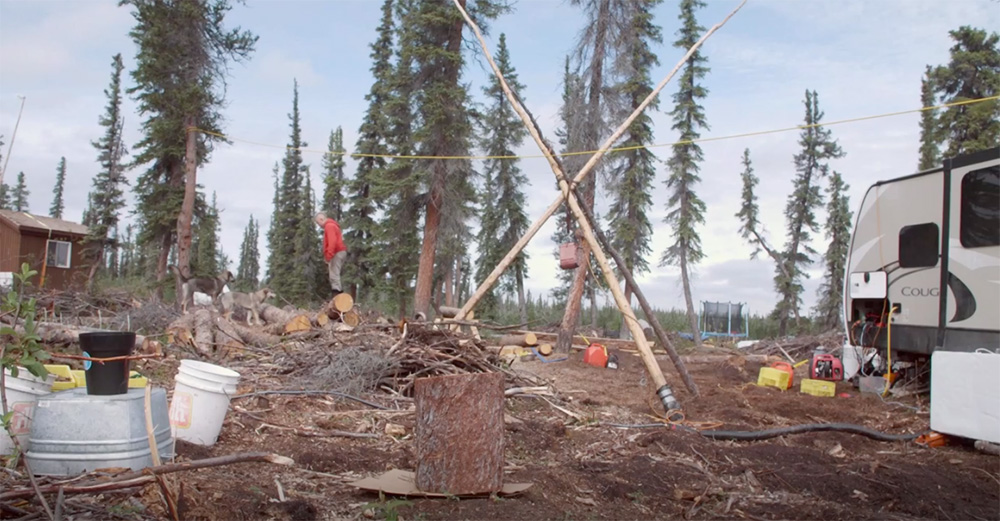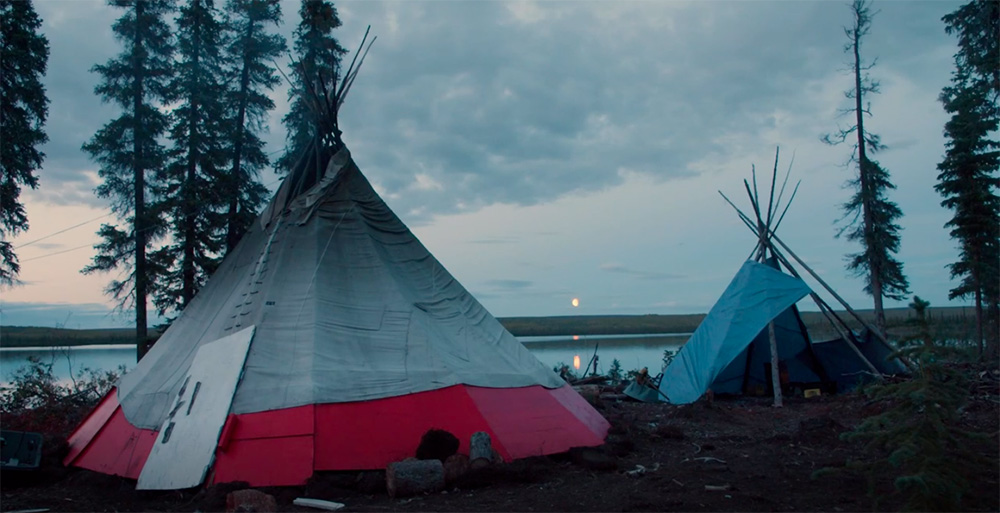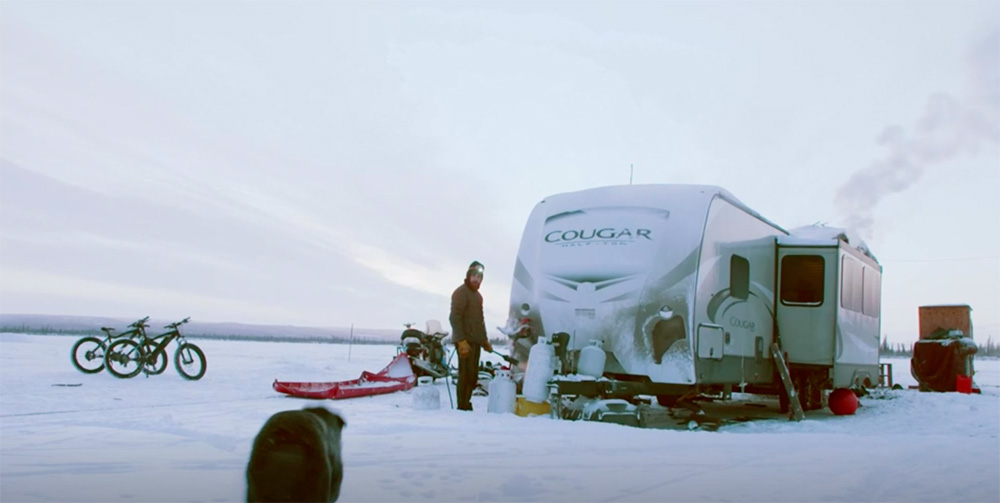Language, Life Skills and Legends in “Okpik: Little Village in the Arctic”
Inuit Art Foundation | September 16, 2022
Categories: news
Language, Life Skills and Legends in “Okpik: Little Village in the Arctic”
Sep 16, 2022
by Jessica MacDonald

Multidisciplinary Inuk artist Tiffany Ayalik takes on directing in her new film Okpik: Little Village in the Arctic. The latest documentary from Copper Quartz Media, which Ayalik helms with long-time producing partner Caroline Cox, Okpik follows Inuit/Gwitch’in hunter-gatherer Kylik Kisoun as he builds an independent, self-sustaining village near Inuvik, Inuvialuit Settlement Region, NT, using traditional sustenance techniques like sod-house building.
The IAQ’s Jessica MacDonald spoke with Ayalik about what it was like to film during the height of the pandemic, the challenges of making a film dubbed in the endangered language Inuvialuktun, and how Kylik’s quest for Indigenous autonomy is reflected not only on screen but also behind the camera.
Jessica MacDonald: Could you talk to me about where the initial idea for the film came from?
Tiffany Ayalik: We [Copper Quartz Media] started our relationship with Kylik several years ago, when we featured him in an episode of a TV show called Wild Kitchen that I hosted and my producing partner Caroline Cox produced and directed. Wild Kitchen was a show that went all across the Northwest Territories, and we got to meet really cool people who are somehow really closely connected to their food, whether they're hunting or foraging or farming or gathering. We really hit it off and became huge fans of what he was doing up in Inuvik with his tour company Tundra North Tours.
We kept our friendship going for many years after that, and then we found out during the pandemic that—like a lot of people in the tourism industry—he had to basically liquidate his business.
He was left with the really tough decision, wondering, 'Do I stay in town and find another job, working 50-60 hours a week doing something I hate in order to be able to afford the super high cost of living in Inuvik, or is there another way to do this?’ He decided the best option was to move his family to his hunting camp outside of Inuvik, and spend five bucks a day and do the work that is required to live out at his bush camp, where instead of trying to buy the power to heat his house, he gets to chop wood, be connected with his kids, feed his family by hunting for moose—doing things that are way more culturally relevant to him and his Inuvialuk family. For him, that was an easy decision to make.
The more time we spent with Kylik, the more we saw that this was a much bigger experiment than just moving his family into the bush. His concept was not only for serving his family, but to create a village that could be a site of housing and food security: a place where people could come out and learn valuable cultural skills and life skills to exist outside of the capitalist world, be surrounded by Elders, have language lessons and be separated from a lot of the distractions in town. And so that's what we spent the year filming with Kylik.
We came once every season, starting in March 2021 and finishing filming March 2022. So we basically spent the calendar year coming in and out every few months to see what was happening, what had been built, how the camp was changing and the progress of the village.
JM: You touched on a couple of the big themes in the film: living sustainably, recentering Indigenous ways of being in the world, housing and food insecurity. Is there a theme that stands above the rest for you in terms of what the film is about?
TA: I think this film is an incredible expression of generosity and love for community. Kylik has a big love for his community, and he sees how much the community struggles. He also has his own struggles, but he's pretty lucky—in a way—to have the capacity to take on these big projects. And they're all for the community: for his kids, first and foremost, and then for the extended community.
He wants to train people, not so that they can just help him build his vision, but to teach life skills. The whole idea is to have people come out and get paid to learn how to build a house, how to go hunting, how to set a fishnet, so that people can go and build their own camp, that they can do this for their families. You can walk away not only with a living wage, but learning these empowering, amazing skills that everybody should have had if colonization didn't happen in the way that it did.
I think that's a theme that runs throughout the whole movie, Kylik’s desire to empower people to take back control and autonomy. He's so generous with his skills, wanting to give back every which way that he can because he believes in his community and wants it to be autonomous and well and healthy and thriving.

JM: As co-directors for the film, how did the two of you work together?
TA: I was structurally putting the story together and working with the editor to make sure that it flowed in the way that I wanted it to, and I brought my own artistic and creative vision to it. But we wanted to give Kylik, in an official capacity, autonomy over how he and his community were being represented.
Part of our philosophy at Copper Quartz Media is to give the subjects of our documentaries power and autonomy in the process, especially Indigenous peoples and in particular Inuit, who have had a pretty horrible history with representation in the film industry over film history. We're depicting Kylik’s life, we're depicting him and his family, his children, and so we want to give him the autonomy and the authority to have final say in how he's depicted and how his story goes out into the world.
Kylik and I have had a friendship for many years, so at the base of our relationship is a lot of trust. We had a really good alignment as a team and as co-directors off the top, which allowed us to trust each other’s instincts [when making choices about the film].
JM: One of the things that struck me as I was watching the film was the soundtrack. I know you have your own musical background, as one of the members of PIQSIQ. Can you tell me a little bit about some of the musical choices you made for the film?
TA: I knew that I wanted music to have an important role in the film, to highlight some of the less obvious emotional currents throughout. I worked very closely with our editors, KI. Peruzzo de Andrade and Erynne Gilpin, who are both very musical and were able to help make some choices while editing that I really loved.
I wanted a northern voice in there; we had worked with Digawolf on our last film, Food For The Rest of Us, and I really loved what he did. He's a Tłı̨chǫ musician, and he has been in and around the North his whole life—I know that affects artists and how we look at and hear the world.
I wanted him to create the soundscape for the traditional Inuit legend that is interwoven with Kylik's story. Diga totally understood the assignment and did such a great job at creating this magical realism that really helps to uplift the film overall.
You also hear a young girl's voice through some of the parts of the opening and the credits, and that's actually Indigo, Kylik's daughter! We got her to do a little improvising for us, and then that was woven into samples from the Inuvik drummers featured in the film.
There’s also one more song that plays when Indigo is growing, which is one I did for a show I created in Vancouver last year, Itqakaijuq/Tries to Remember (2021). It was another beautiful opportunity to have more Inuit language featured in the film.
JM: Speaking of Inuit language, you’ve also released a version of the film that’s entirely dubbed in Inuvialuktun. What inspired you to pursue the film in a second language?
TA: We felt it was important not only to tell this story but also to leave the community with a language resource. Inuvialuktun is one of the most endangered Inuit languages in the North. There are only 20% of fluent speakers in the Inuvialuit Settlement Region, and all of those speakers are well into their elder years.
We felt it was important to dub the whole film in Inuvialuktun as a legacy piece, to have a language resource where people could watch the film, practice along and listen to it. Who knows, maybe this will help make other Inuvialuktun films happen? It's my dream to have big blockbuster movies like Prey translated into Inuvialuktun so that young people can grow up seeing cool pop culture, things that they're into, in Inuvialuktun.
I was really daunted by it at first, and it was a huge undertaking. We worked with some amazing translators: Clara Day, who voices the legend, and her sister, Mary Allen, worked so hard at translating the entire film into Inuvialuktun. For the most part, the people who are speaking in the film did their own voice overs.
As long as you are budgeting the time, energy and resources to support it, it's an amazing thing to tackle even if you don't have a huge amount of fluency. I didn't have to be a fluent speaker in order to help produce a fluent project. It was an amazing experience to work so closely with the translators; to be able to have total immersion in language was a profound experience as a filmmaker.
I hope that there continues to be funding and support to help with this work, because it's definitely work that needs big money and power behind it to make sure that the language does stay around.

JM: Can you tell me a little bit about this film as part of your own journey as a filmmaker? How does this fit with the other films you've worked on in the past?
TA: It was a huge growth project for me. It was my first time where I felt like I was really in the director's chair. I got a lot of really great mentorship from my longtime collaborator, Caroline Cox. She told me, 'It's a team—you don't have to feel stressed about having every single one of the answers before you start. That's the process of investigation and collaboration.'
I also learned to trust my instincts. I’m an Indigenous woman in the film industry, and there's not a lot of people like me. It's a small community and we don't see ourselves represented very often or very positively, so you can feel like an imposter. You ask, 'Who am I to take on this project, or tell that story, or play this role?' But throughout the process I saw how amazing it is when Indigenous people are not only in front of the screen, but behind the camera working together. When we have autonomy over how our own cultures and stories are represented, that's really powerful. Finding the community and collectivity in that process was a powerful experience for me, and something I want to keep creating with my future projects.
JM: What would you say was the biggest creative risk you took?
TA: I think that including the legend was one of the more risky things that I did. I'm really pleased that choice paid off, because I feel like it really adds this beautiful, magical layer to the everyday processes of cutting wood, making beams and creating the foundation of a cabin.
This legend really illustrates how these forces that Kylik, his family and his philosophy of the village are fighting against are sometimes mythic, big forces. This creature in the legend, who eats and eats and is never going to be full, was my metaphor for capitalism. This creature keeps the community captive, afraid to upset it, and they're all held hostage.
The hero of the story, the orphan, very much aligns with Kylik and his life experience, trying to find a different way to live outside of capitalism, this creature that has held his community captive for so long. That was a big swing on my part, and I'm really glad it paid off because I think it's a really beautiful interwoven element throughout.

JM: What has the response to the film been like so far?
TA: I've shown it to my friends and colleagues and I've got some pretty great responses from them. It was my dream to have a big community screening, but it’s not the best time to do that necessarily, with the pandemic.
The Inukvialuktun version just went up on CBC Gem, so I'm happy it’s up and out in the world. I'm hopeful that it will continue to trickle through the North and South, and that it will resonate with people—that Kylik and his experiment will continue to get the attention they deserve. And it might help to get people thinking a little bit more about food and housing insecurity, even if it doesn't impact them directly, how they can look to support initiatives in their own community. In the North, there is huge housing insecurity, huge food insecurity and the cost of living is incredibly high. We have overcrowding in so many homes. It is a real crisis that lots of the North is going through every single day, but few people outside the North see.
JM: Is there anything that you might want to say to artists who might be thinking about taking on projects like this?
TA: Creative risk is always a scary and vulnerable undertaking. But for the most part, you regret not taking the risk more than taking it.
I really encourage creators, especially if they're Inuk—wherever they are, whatever their medium—to be brave and to take risks. Try and experiment; if it works, it works and if it doesn't, now you know. Don't let the possibility of it not working be the thing that prevents you from trying and experimenting because not knowing is a beautiful place to create from. I think a lot of magic, openness and spontaneity comes from that place. If you're open and listening and available to some of those impulses, they can take you to some really beautiful places.
Okpik: Little Village in the Arctic is now available in English and Inuvialuktun on CBC Gem.


